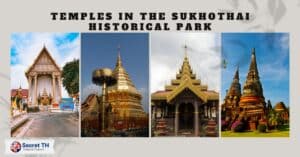Sukhothai, Thailand’s inaugural kingdom, holds a captivating historical journey. Established in the 13th century, it flourished as a center of art, culture, and governance. Its architectural marvels, including the iconic Wat Mahathat, showcase the kingdom’s grandeur. Today, Sukhothai remains a cherished UNESCO World Heritage site, preserving the legacy of Thailand’s first kingdom.
Stay with us as we delve into these fascinating questions, retracing the steps of ancient kings, exploring the architectural marvels they left behind, and immersing ourselves in the vibrant culture that flourished under their rule. Let’s embark on this historical journey together, embracing the spirit of conservation and respect for this invaluable piece of our shared human heritage. Are you ready? Let the adventure begin!
Ancient Origins of Sukhothai
Embark on a captivating voyage into the past as we explore the ancient origins of Sukhothai, the city that served as the seedbed of Thai civilization. Set against a backdrop of lush landscapes, this remarkable kingdom was sculpted by natural splendor, cultural amalgamation, and the indomitable spirit of its people.
Geographical Location and Natural Beauty
The historical city of Sukhothai is nestled in the fertile valley of the Yom River, surrounded by a panorama of rolling mountains. This picturesque landscape, coupled with an abundance of natural resources, made it an attractive region for early settlers and fostered the rise of the Sukhothai Kingdom.
Influence of Neighboring Civilizations
The evolution of Sukhoi’s cultural fabric was heavily influenced by neighboring civilizations, particularly the Mon, Khmer, and later, the Tai peoples. Trade, warfare, and diplomatic relations exposed Sukhothai to a cross-pollination of ideas, art, religious practices, and administrative systems from these neighboring societies.
The emergence of the Sukhothai Kingdom
Sukhothai emerged as a powerful entity around the mid-13th century. Unifying the disparate Tai principalities, the Kingdom carved out a sizable realm that stretched beyond present-day Thailand. The establishment of Sukhothai as an independent entity marked the dawn of the Thai nation-state.
The echoes of this dawning era continue to reverberate, shaping Thailand’s identity and destiny. The story of Sukhothai serves as a compelling prologue to the epic tale of the Thai nation.
For pictures and more information, click here.

Rise and Golden Age of Sukhothai
The ascension of King Ramkhamhaeng in the late 13th century heralded Sukhothai’s golden age. Known for his wisdom, valor, and visionary leadership, King Ramkhamhaeng was instrumental in expanding Sukhothai’s territory, establishing diplomatic relationships, and fostering cultural, religious, and economic prosperity.
Sukhothai flourished economically during its golden age, cultivating vibrant trade networks with China, India, and the Malay Archipelago. The city became a bustling hub for commerce, with merchants trading in silk, ceramics, precious stones, and spices. The introduction of standardized weights and measures further stimulated the economy and facilitated international trade.
Sukhothai’s golden age saw a flourishing of art and architecture. Innumerable temples, monasteries, and statues were erected, showcasing the kingdom’s unique aesthetic sensibilities. The most prominent of these include Wat Mahathat, Wat Si Chum, and Wat Sa Si, which still inspire awe today.

Cultural and Religious Significance
During the Sukhothai period, Theravada Buddhism became the dominant religious and philosophical ideology. It influenced social conduct, ethics, art, and politics, while also serving as a unifying force for the kingdom’s diverse population.
While Theravada Buddhism was paramount, Sukhothai was a cultural melting pot where Hindu and Khmer traditions also left indelible marks. Elements of Hindu cosmology and Khmer architecture, evident in many Sukhothai temples and monuments, highlight this cultural syncretism.
Sukhothai’s cultural heritage extends beyond architecture to include dance, music, sculpture, and literature. Its cultural traditions, carefully preserved and passed down through generations, remain an integral part of Thai identity.

Sukhothai’s Influence on Thai Identity
Journey with us as we delve into the profound influence of Sukhothai on Thai identity. The kingdom’s rise marked a seminal point in the history of Thailand, setting the cultural, linguistic, and political foundation upon which the Thai nation has been built.
1. Impact on Language, Art, and Literature
King Ramkhamhaeng’s invention of the Thai script gave the Thai people a distinct linguistic identity, while the flourishing arts scene fostered a rich literary tradition. Sukhothai-style art, characterized by its grace, elegance, and spirituality, significantly shaped Thai aesthetic sensibilities.
2. Development of Thai Governance and Administrative Systems
King Ramkhamhaeng, the celebrated ruler of Sukhothai, implemented a unique paternalistic administrative system, heralding a new era of governance. His approachable style contrasted with the prevailing autocratic systems, emphasizing fairness and empathy. He was viewed as a ‘father’ figure by his people, and he prioritized justice, famously hanging a bell in the palace square for anyone with grievances to ring.
3. Influence on Subsequent Thai Kingdoms
The legacy of Sukhothai extended beyond its reign, with its cultural, religious, and political ideologies profoundly influencing subsequent Thai kingdoms. The Ayutthaya and Bangkok periods, despite developing their distinctive styles, carried forward Sukhothai’s imprint in various forms.
As we draw this exploration to a close, we are reminded of the enduring legacy of Sukhothai. From its unique artistic style to its innovative governance system, Sukhothai’s imprint continues to shape and define Thai identity. The echoes of this great kingdom, woven into the tapestry of Thai life, underscore the nation’s rich heritage and its optimistic path into the future.

Decline and Legacy of Sukhothai
In the 15th century, Sukhothai faced increasing internal conflicts and external pressures. With shifting trade routes and the rising power of the Ayutthaya Kingdom, Sukhothai struggled to maintain its economic and political dominance.
Despite a determined resistance, Sukhothai finally succumbed to Ayutthaya in the mid-15th century. While its fall marked the end of Sukhothai’s political dominance, its cultural and historical influence lived on, shaping the course of Thai history.
The ruins of Sukhothai, now a World Heritage Site, stand testament to its glorious past. Thanks to preservation and restoration efforts by the Thai government and UNESCO, we can still glimpse Sukhothai’s grandeur today.

Exploring Sukhothai Today
Designated as a UNESCO World Heritage Site in 1991, Sukhothai is recognized for its outstanding universal value. The historical park, encompassing ruins of royal palaces, Buddhist temples, city gates, walls, moats, and sculptures, offers a window into the kingdom’s remarkable past.
The Sukhothai Historical Park, akin to an open-air museum, is a treasure trove for history enthusiasts, art aficionados, and cultural explorers. The beautifully restored structures, set against the backdrop of lush gardens and tranquil ponds, make it a must-visit destination for all.
A trip to Sukhothai offers visitors a chance to step back in time. Whether it’s cycling through ancient ruins, participating in traditional festivals, or marveling at artistic masterpieces, Sukhothai provides a rich, immersive historical experience.

Conclusion
The historical journey of Sukhothai is a testament to Thailand’s rich cultural heritage, resilience, and spirit of innovation. The kingdom’s rise to prominence, its golden age of prosperity, and its enduring influence provide valuable insights into the foundations of Thai identity.
Preserving Sukhothai’s heritage is crucial for understanding Thailand’s past and its trajectory into the future. Each artifact, monument, and historical narrative from Sukhothai enables us to appreciate the nuances of Thai culture, art, politics, and religion.








